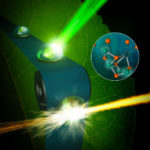Molecular Biophysics & Integrated Bioimaging (MBIB) Division scientists Aaron Brewster, Nicholas Sauter, and James Fraser were part of an international team led by William DeGrado at UCSF that used an X-ray free-electron laser (XFEL) source to visualize the arrangement of water molecules inside the influenza matrix 2 (M2) channel at room temperature. The M2 channel of influenza A is essential for the reproduction of the flu virus, making it a target for therapeutics, and it is also a model system for studying how protons are transported across a membrane bilayer. The XFEL method overcomes the limitations of previous crystallographic structures obtained using synchrotron radiation with cryocooling. While cryocooling helps to preserve crystals against rapid radiation damage, it imparts an artificially higher degree of order of the water molecules than structures obtained near room temperature. By using room temperature XFEL to study the M2 channel at various pH conditions, the researchers have gained a more accurate picture of the behavior of water molecules and their role in proton transport in these channels. The study was published in the Proceedings of the National Academy of Sciences.
Brain-Inspired Chips for Big Data Science
With funding from the Department of Energy’s (DOE’s) Laboratory Directed Research and Development (LDRD) program, Berkeley Lab researchers from the Computational Research Division (CRD) and the Biosciences Area are collaborating to explore how brain-inspired computer chips might benefit science.
X-rays Capture Unprecedented Images of Photosynthesis in Action
An international team of scientists is getting closer to discovering how plants split water during photosynthesis and produce nearly all of the oxygen in our atmosphere. Thanks to unprecedented, atomic-scale images of a protein complex found in plants, algae, and cyanobacteria captured by ultrafast X-ray lasers, researchers conducted atomic-level experiments to help delineate the mechanism of this system that also yields the protons and electrons used to reduce carbon dioxide to carbohydrates later in the photosynthesis cycle. The effort to uncover the secrets of this protein complex, photosystem II, was led by Vittal Yachandra and Junko Yano in the Molecular Biophysics & Integrated Bioimaging (MBIB) Division and the team’s findings were published this week in Nature.
Biosciences Researchers to Support Two Exascale Projects
Biosciences researchers will contribute their expertise to two new projects, “Data Analytics at the Exascale for Free Electron Lasers” and “Exascale Solutions for Microbiome Analysis,” funded by DOE to develop cutting-edge research applications for next-generation supercomputers as part of DOE’s Exascale Computing Project (ECP), a component of President Obama’s National Strategic Computing Initiative that intends to maximize the benefits of high-performance computing for U.S. economic competiveness, national security and scientific discovery. ECP announced its first round of funding on September 7 with the selection of 15 application development proposals for full funding and seven proposals for seed funding.
X-rays Reveal New Path In Battle Against Mosquito-borne Illness
MBIB researchers were part of a team that used SLAC’s X-ray free-electron laser (XFEL) – the Linac Coherent Light Source (LCLS), a DOE Office of Science User Facility – to get atomic views of the toxin BinAB, used as a larvicide to control mosquito-borne diseases such as malaria, West Nile virus and viral encephalitis. The structure of this bacterial toxin was solved using de novo phasing: the protein crystals were tagged with heavy metal markers, tens of thousands of diffraction patterns were collected using the XFEL, and the information was combined to obtain a three-dimensional map of the electron density of the protein. The Berkeley team, headed by Senior Scientist Nicholas Sauter, acquired and processed data for the study, published in Nature last week.
Was this page useful?








